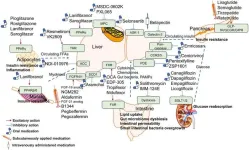(Press-News.org)
Non-alcoholic fatty liver disease (NAFLD), recently reclassified as metabolic dysfunction-associated steatotic liver disease (MASLD), has become the most prevalent chronic liver disease globally. This reclassification underscores the metabolic dysfunction central to the disease, which spans a spectrum from simple steatosis to more severe forms like steatohepatitis, fibrosis, and cirrhosis. Given the significant overlap between MASLD and type 2 diabetes mellitus (T2DM), the therapeutic strategies for MASLD have increasingly focused on addressing metabolic derangements. Despite its global prevalence, no specific drugs have been approved for MASLD, highlighting an urgent need for effective pharmacological interventions.
Antidiabetic Agents
Given the close association between MASLD and T2DM, antidiabetic medications have been extensively explored as potential therapies. This category includes glucagon-like peptide-1 (GLP-1) receptor agonists, sodium-glucose cotransporter 2 (SGLT2) inhibitors, and thiazolidinediones. GLP-1 agonists, such as liraglutide and semaglutide, have shown promise in reducing hepatic steatosis and inflammation by lowering body weight and insulin resistance. Tirzepatide, a dual GLP-1/GIP agonist, has demonstrated a substantial reduction in liver fat and inflammation, positioning it as a potential MASLD therapy. However, while these agents improve metabolic parameters, their long-term efficacy in preventing fibrosis progression remains under investigation.
Targeting Hepatic Lipid Accumulation
Hepatic lipid accumulation is a key driver of MASLD pathogenesis. Therapeutic strategies targeting this pathway include peroxisome proliferator-activated receptor (PPAR) agonists, bile acid-farnesoid X receptor (FXR) agonists, and de novo lipogenesis (DNL) inhibitors. PPAR agonists, such as pioglitazone and elafibranor, have shown efficacy in improving liver histology but are associated with side effects like weight gain. FXR agonists, including obeticholic acid (OCA), have demonstrated significant histological improvements, although concerns about pruritus and adverse cardiovascular effects have tempered enthusiasm. Meanwhile, DNL inhibitors like aramchol have shown potential in early trials, though further studies are needed to confirm their long-term benefits.
Targeting Oxidative Stress, Inflammation, and Fibrosis
Oxidative stress, inflammation, and fibrosis are pivotal in MASLD progression. Antioxidants such as vitamin E, anti-inflammatory agents like emricasan, and antifibrotic drugs like cenicriviroc are being explored for their potential to mitigate these processes. While these agents have shown varying degrees of success in clinical trials, their impact on long-term outcomes remains uncertain. The combination of these agents with other therapeutic strategies may enhance their efficacy and reduce side effects.
Gut Microbiota and Enterohepatic Axis
The gut-liver axis plays a crucial role in MASLD pathogenesis, making it a target for emerging therapies. Agents like IMM-124e, which targets gut microbiota, and solithromycin, a novel macrolide antibiotic, are under investigation for their potential to modulate this axis. Although these approaches are in the early stages of clinical development, they represent a promising avenue for MASLD treatment.
Combination Therapies
Given the complex and multifactorial nature of MASLD, combination therapies targeting different pathogenetic pathways may offer a more effective approach. Such combinations could potentially enhance therapeutic efficacy while minimizing side effects. Ongoing clinical trials are exploring various combinations of antidiabetic agents, PPAR agonists, FXR agonists, and other novel compounds.
Conclusions
MASLD represents a significant and growing public health challenge, with no currently approved pharmacotherapies. However, the expanding pipeline of drug candidates targeting various aspects of MASLD pathogenesis offers hope for effective treatments. As research progresses, it is likely that combination therapies will play an increasingly important role in managing this complex disease, offering new hope to patients at risk of advanced liver disease and its complications.
Full text
https://www.xiahepublishing.com/2310-8819/JCTH-2024-00123
The study was recently published in the Journal of Clinical and Translational Hepatology.
The Journal of Clinical and Translational Hepatology (JCTH) is owned by the Second Affiliated Hospital of Chongqing Medical University and published by XIA & HE Publishing Inc. JCTH publishes high quality, peer reviewed studies in the translational and clinical human health sciences of liver diseases. JCTH has established high standards for publication of original research, which are characterized by a study’s novelty, quality, and ethical conduct in the scientific process as well as in the communication of the research findings. Each issue includes articles by leading authorities on topics in hepatology that are germane to the most current challenges in the field. Special features include reports on the latest advances in drug development and technology that are relevant to liver diseases. Regular features of JCTH also include editorials, correspondences and invited commentaries on rapidly progressing areas in hepatology. All articles published by JCTH, both solicited and unsolicited, must pass our rigorous peer review process.
Follow us on X: @xiahepublishing
Follow us on LinkedIn: Xia & He Publishing Inc.
END
September 25, 2024 (Washington, DC)—The Kissick Family Foundation Frontotemporal Dementia (FTD) Grant Program, in partnership with the Milken Institute Science Philanthropy Accelerator for Research and Collaboration (SPARC), today announced six research teams awarded two-year grants to advance scientific understanding of FTD, totaling $3 million in new funding for this disease.
This inaugural cycle of the Kissick Family Foundation FTD Grant Program represents a unique philanthropic strategy that specifically targets basic or early-stage translational research projects that focus on those disease cases ...
Metastatic cancer can be a devastating diagnosis. The cancer is spreading. It may travel to multiple organs in the body. This could mean more pain and ultimately, death.
Unfortunately, just how cancer spreads remains unclear. But now, Cold Spring Harbor Laboratory (CSHL) Professor Adam Siepel and colleagues have a way to better understand that process. New technology developed at Weill Cornell Medicine barcodes cells to track the highways by which prostate cancer spreads throughout the body.
The resulting roadmap shows that most cancer cells actually stay put within the tumor. However, ...
Augmented reality (AR) takes digital images and superimposes them onto real-world views. But AR is more than a new way to play video games; it could transform surgery and self-driving cars. To make the technology easier to integrate into common personal devices, researchers report in ACS Photonics how to combine two optical technologies into a single, high-resolution AR display. In an eyeglasses prototype, the researchers enhanced image quality with a computer algorithm that removed distortions.
AR systems, like those in bulky goggles and automobile head-up displays, require portable optical components. But shrinking the typical four-lens AR system to the size of eyeglasses or smaller ...
Professor Ron Boschma is the first Dutch person to receive the Prix Vautrin Lud, the highest academic award within the field of geography. The award will be presented in Saint-Dié-des-Vosges, France on 6 October. Prior to the award ceremony, Prof. Boschma will give an invited lecture at the Sorbonne University in Paris on 4 October. Boschma was nominated for the award in recognition of his scientific contributions to the field of economic geography, especially for laying the foundations of evolutionary economic geography and his research into regional diversification and innovation policy. The European Union’s regional policy is based in part on his ...
Research Highlights Risk to Both Humans and Wildlife, Suggests Need for New Collision Mitigation Strategies
A recent article published in PeerJ Life & Environment has uncovered insights into how mallards (Anas platyrhynchos) respond to approaching vehicles, revealing that these common waterbirds are poorly equipped to avoid collisions, particularly at high speeds. The research, which used both simulated and real-world vehicle approaches, highlights the urgent need for improved methods to reduce bird-vehicle collisions—events that are not only financially costly but also dangerous to both humans and wildlife.
The study focused ...
About The Study: In this randomized clinical trial, home-based phototherapy was as effective as office-based phototherapy for plaque or guttate psoriasis in everyday clinical practice and had less burden to patients.
Corresponding Author: To contact the corresponding author, Joel M. Gelfand, MD, email joel.gelfand@pennmedicine.upenn.edu.
To access the embargoed study: Visit our For The Media website at this link https://media.jamanetwork.com/
(doi:10.1001/jamadermatol.2024.3897)
Editor’s Note: Please see the article for additional information, including other authors, ...
Large expansion of carbon capture and storage is necessary to fulfill the Paris Climate Agreement. Yet a new study led by Chalmers University of Technology, in Sweden and University of Bergen, in Norway, shows that without major efforts, the technology will not expand fast enough to meet the 2°C target and even with major efforts it is unlikely to expand fast enough for the 1.5°C target.
The idea behind carbon capture and storage (CCS) technology is to capture carbon dioxide then store it deep underground. Some applications of CCS, such ...
An “invisible forest” of phytoplankton is thriving in part of our warming ocean, new research shows.
Phytoplankton are tiny drifting organisms that do about half of the planet’s “primary production” (forming living cells by photosynthesis).
The new study, by the University of Exeter, examined phytoplankton at the ocean surface and the “subsurface” – a distinct layer of water beneath – to see how climate variability is affecting them.
Published in the journal Nature Climate Change, the findings show these two communities are reacting differently.
Over the last decade, the total “biomass” (living material) of subsurface ...
Whether we are predisposed to particular diseases depends to a large extent on the countless variants in our genome. However, particularly in the case of genetic variants that only rarely occur in the population, the influence on the presentation of certain pathological traits has so far been difficult to determine. Researchers from the German Cancer Research Center (DKFZ), the European Molecular Biology Laboratory (EMBL) and the Technical University of Munich have introduced an algorithm based on deep learning that can predict the effects of rare genetic variants. The method allows persons with high risk of disease to be distinguished more precisely and facilitates the identification ...
The hype surrounding machine learning, a form of artificial intelligence, can make it seem like it is only a matter of time before such techniques are used to solve all scientific problems. While impressive claims are often made, those claims do not always hold up under scrutiny. Machine learning may be useful for solving some problems but falls short for others.
In a new paper in Nature Machine Intelligence, researchers at the U.S. Department of Energy’s Princeton Plasma Physics Laboratory (PPPL) and Princeton University performed a systematic review of research comparing machine learning to traditional methods for solving ...








